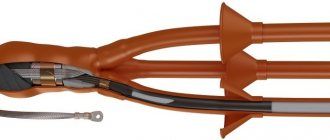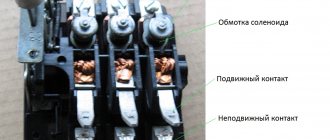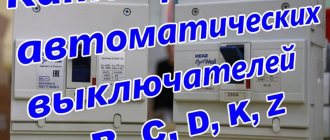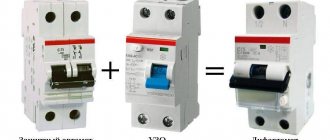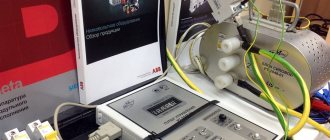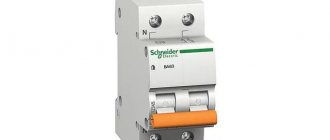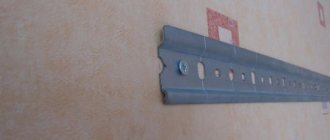Circuit breakers are devices whose task is to protect an electrical line from exposure to powerful current that can cause overheating of the cable with further melting of the insulating layer and fire. An increase in current strength can be caused by too much load, which occurs when the total power of the devices exceeds the value that the cable can withstand in its cross-section - in this case, the machine does not turn off immediately, but after the wire heats up to a certain level. During a short circuit, the current increases many times over within a fraction of a second, and the device immediately reacts to it, instantly stopping the supply of electricity to the circuit. In this material we will tell you what types of circuit breakers are and their characteristics.
Why change Soviet machine guns to modern ones?
I was planning to do some electrical upgrades in the apartment, but I was afraid that an unintentional short circuit might cause a big bang. After all, even manual shutdown occurred with great effort and creaking. Therefore, I was not at all sure that during an overcurrent the shutdown would occur exactly where it was needed - inside the circuit breaker (AB).
In addition, according to generally accepted safety standards today, installing AVs with a rated current of 25 A on socket groups (and even more so on lighting groups) is bad form. Indeed, with such AB ratings and wire cross-sections (2.5 mm2 for aluminum), the operation of electrical wiring becomes unsafe. The wires will be periodically heated, which will not improve their properties.
In addition, the condition of the twists, terminals and contacts over more than 30 years of operation is, to put it mildly, not very good. In other words, the transition resistances in this electrical installation are increased uncontrollably.
And this, in turn, leads to a low short-circuit current, which I recently measured using improvised means. The current in the apartment turned out to be very low - about 170 A. Why low short-circuit current is dangerous, read my other article.
There were no plans to change all the wiring, so to increase safety, it was decided to install new AVs with lower ratings.
A few more links if the topic is interesting.
- Everything about the characteristics of circuit breakers, with examples and GOST standards.
- How modern circuit breakers work from the inside.
- Everything related to the installation of machines and other devices
- All articles about power supply - meters, generators, stabilizers, etc.
Automatic safety switches: classification and differences
In addition to residual current devices, which are not used individually, there are 3 types of network circuit breakers. They work with loads of different sizes and differ in their design. These include:
- Modular AV. These devices are installed in household networks in which negligible currents flow. Typically have 1 or 2 poles and a width that is a multiple of 1.75 cm.
- Molded switches. They are designed to operate in industrial networks with currents up to 1 kA. They are made in a cast case, which is why they got their name.
- Air electric machines. These devices can have 3 or 4 poles and can handle currents up to 6.3 kA. Used in electrical circuits with high power installations.
There is another type of circuit breaker for protecting the electrical network - differential. We do not consider them separately, since such devices are ordinary circuit breakers that include an RCD.
Changing Soviet machine guns
I don’t know why it was necessary to install 25 A automatic machines in Soviet apartments? This only added more work to the electricians from the housing office during short circuits, who were present quite often, and there were no particularly powerful consumers in the apartments. What did you have to load this machine with in order for it to knock out? Should we include 10 refrigerators? Or several stoves? The wires will melt before this old guy can break them off!
The paradox is that there were almost no overloads (there was nothing special to load), but short circuits occurred quite often. But the AB25M automatic machine, which is discussed in the article, saves only from overloads, but not from short circuits - it simply does not have an electromagnetic release! But I got ahead of myself, let’s continue in order.
This is what the electrical panel on the landing of a standard Soviet 9-story panel building looked like over 30 years of work:
Electrical panel in the entrance of a panel house. I think this is a painfully familiar picture to many of my readers...
Closer view of the area where you will be working:
Vending machines in a panel at the entrance. Mine are top left, AB25M
Closer - the upper terminals of my machines and the “zero bus”:
Upper terminals of Soviet AB25M assault rifles
Bottom view:
Bottom terminals of Soviet automatic machines and input switch
My area of responsibility is 3 AB25M automatic machines and a batch input switch (on the left).
Please note (although many people are aware, I know) - there have been no handles on switches for many years, and this situation is everywhere. The fact is that the design is very inconvenient - to get to the machines, you need to remove the cover, and to do this, remove these handles from the switches, and to do this, unscrew 4 M4 screws (not to mention the screws holding the cover). Screws are lost, handles are thrown away, and shutdown is usually done with pliers, which does not contribute to efficiency and safety (((
Characteristics of circuit breakers
There is another classification of machines - according to their characteristics. This indicator indicates the degree of sensitivity of the protective device to exceeding the rated current. The corresponding marking will show how quickly the device will react in the event of an increase in current. Some types of AVs work instantly, while others will take some time.
There is the following marking of devices according to their sensitivity:
- A. Switches of this type are the most sensitive and react instantly to increased load. They are practically not installed in household networks, using them to protect circuits that include high-precision equipment.
- B. These machines operate when the current increases with a slight delay. They are usually included in lines with expensive household appliances (LCD TVs, computers and others).
- C. Such devices are the most common in household networks. They are turned off not immediately after increasing the current strength, but after some time, which makes it possible to normalize it with a slight difference.
- D. The sensitivity of these devices to increasing current is the lowest of all types listed. They are most often installed in shields at the line approach to the building. They provide security for apartment automatic machines, and if for some reason they do not work, they turn off the general network.
Installation of new circuit breakers to replace old ones
I will say right away, responding to the claims of beauty enthusiasts. This is not Instagram, where the main thing is the picture. In my blog I show not gloss, photoshop and beauty, but real life. But in real life, anything can happen - crooked, askew, dirty, and dangerous.
Those who are spoiled by perfect Instagram pictures and pretentious chicks are definitely not for me. Come to me for real life without embellishment.
So, we don’t throw away the old AVs yet (they will be useful for the review), but we start installing the new ones from the DIN rail:
DIN rail for new machines in the panel
You can see one suitable wire (after the meter) 4 mm2 from below, and two going into the apartment.
I install new AVs, Schneider Electric Easy 9 with a rated current of 16 A and shutdown characteristic “C”:
New Schneider Electric assault rifles to replace the old Soviet AB25M
Why are there 2 wires, and the third one is wrapped with electrical tape? The third wire is intended for a powerful kitchen outlet, and is walled up somewhere under the tiles and kitchen units in the apartment. I installed the third AB, one might say, in reserve, especially since it was purchased in advance.
New Schneider machines, connection from above
Why Schneider and not IEK or ABB? I believe that 90% of the success and duration of operation of an electrical panel depends not on components, but on correct calculation, quality of installation and proper operation. This is exactly what I answer when people ask me “which brand should I choose?”
By the way, recently there was an article on the blog about how I went to Moscow at the invitation of IEK. The article is a detailed report of what was shown and told there.
Look at the ABB machine to the right with a rating of C25 - two wires are connected to its upper terminal. When the aluminum starts to burn, and this will definitely happen, bewilderment will arise: “How so, this is ABB! Probably fake!” Reasons why this terminal will light up?
- The current can be 25 x 1.45 = 36 A for an hour, taking into account the time-current characteristics and the fact that the temperature in the entrance drops significantly in winter.
- The wires are most likely not stripped and are not pulled through periodically.
I carefully clean the wires and make a loop to increase the contact area. In addition, the current through the contact (and through the wire, of course) is limited by the rating of the machine.
What's up with the neighbors?
In such cases, I try to touch less wires that are not relevant to my business. Otherwise, an unpleasant incident may occur. Adding spice to the work are the curious grannies-neighbors, who strive to ask stupid questions and make pessimistic forecasts. Some even start pulling live wires!
The neighbors' wires and automatic machines are complete chaos and inconsistency.
The lower terminals of the machine are burning
Here the contact will soon disappear completely, for the reasons described above.
View of the same machines from above. Almost untouched Soviet rarities. Twisting under PPE - total zero(((
The terminals are burning, I can’t look at this mess
Masterpiece. Zero tires. The main thing is not to touch anything!
The general working zero was done “coolly” - twisting wires of all kinds through PPE. I remembered my article about the differences between the consequences of a zero break in a single-phase and three-phase power supply network.
Please note that TDM circuit breakers are equipped with PVS3x2.5 to power new loads. This was done during a major renovation in a neighboring apartment. Despite the fact that here, too, one can pour negativity, everything is strategically correct - when the load increases and powerful appliances appear (such as an electric stove, air conditioner, boiler), the best solution is to lay a new line and connect it through a separate machine.
AB25M circuit breakers made in the USSR - what's inside?
To be honest, I put off writing this article for a long time, until I was prompted to do so by a reader from Zen, who left a comment on the article about Crash and trash in the electrical panel of a Taganrog dorm:
– The modern ones are losing to the old Soviet ones. The only plus about the new ones is good clamps. Here the new ones win.
– In what ways do the new modern ones lose to the Soviet ones, who worked for 30 years?
- In many ways. Live parts are iron. The contacts are scanty, we haven’t seen any silver. When turned on, there is no clear and quick turn on (click). Those. the contact is made slowly, under the action of the operator’s finger, and is not thrown by a spring. It ends up burning. The arc chamber is funny and small. The distance between the contacts in the off state is also small. Not for inductive loads. The body is not thermoset plastic, but regular meltable plastic. The ebbs in it for fastening the mechanism elements are weak. Also, mechanics with plastic parts are unreliable. Already when buying in a store you come across defective ones. Switching on fails. As a result, the resource is low. In general, we saved on everything.
This hurt me, and I decided to carry out my plans, having received such a peculiar kick)
I already wrote about the disadvantages of modern circuit breakers in the article Automatic and fuse - what's the difference?
So, AB25M assault rifles. Such switches were previously used in all Soviet apartments, except that Siemens installed them in elite ones.
AB25 M Soviet circuit breakers
Isn't it very brutal?
Terminals, bottom view. The rating is very low((
AB25 25A side view of the nameplate. I wonder why the release characteristic is not indicated? )))
The year of manufacture is the same as mine. I came across 3 machines, but it seems that one of them was made using different molds. The only obvious difference was in the degree of protection - IP10, IP20. I took apart both of them - I didn’t see any differences in IP.
The lower terminals are nonsense, they burn and rust, which is basically the same thing
As you can see, the terminals are the weakest point of these AVs.
I wonder where they copied and pasted them from? The Germans?
Above the bottom terminal there are screws for adjusting the thermal release. I talked about these on my Zen, in an article about regulation in modular circuit breakers, which no one knows about.
By the way, here is a screw with the same functionality in the AB Schneider, which I installed as a replacement:
Release adjustment screw, under the terminal
Let's look at:
Disassembling AB25M
The rivets (bushings) are very powerful, made of thick metal. Drilled it out with a 4.5 drill.
The mechanism is on:
Soviet machine gun from the inside
Now this is crazy, but there is no electromagnetic release inside at all! This suggests that even with a short circuit with real values (hundreds of amperes), the shutdown will take several agonizing, hot, fiery seconds! During this time, everything that is possible will burn out and melt! Conclusion – there is zero fire danger!
I removed the arc chute. Closed contacts visible
AB25M, arc chute closer
We completely disassemble, spare parts are in sight:
We look at the AB25M contacts - they say they are made of silver! didn't check.
It can be seen that this machine hardly had to open during overcurrent - the contacts are almost clean. For more than 30 years of work! By the way, they say that AB25 assault rifles have a fairly high content of precious metals, and they are hunted, who knows. I don't know, so it all went in the trash.
On the bimetallic plate it is written: “NICKOVAR”. Who knows what this means? Where is the bimetal produced?
How does this fire-hazardous miracle of Soviet electrical engineering work? Explanatory picture:
Operating principle of the Soviet circuit breaker AB25M
The bimetallic plate bends under the influence of current (movement 1) and disengages the lever (2), at the other end of which there is a moving contact. By the way, when manually disengaged, disengagement does not occur.
The lever rises under the action of the spring and pushes the getinax indicator plate (3) out.
In this case, the lever remains on, as in the photo. There is not even a “Trip” position, as in some powerful machines. To cock and turn on this machine, you need to guess! click that invisible brown flag. Then the bimetallic plate and the movable contact lever will engage, and the machine is ready for operation. But it is not exactly)))
Honestly, there may be silver in the contacts of Soviet switches, but after this analysis I still trust modern machines more than ancient ones!
Therefore, my advice to you is that if you wanted to change the Soviet machine guns in your dashboard, let this article be for you at the same time a push, a magic kick and a sign from above!
Types of releases
Releases are the main operating components of the automatic circuit breaker. Their task is to break the circuit when the permissible current value is exceeded, thereby stopping the supply of electricity to it. There are two main types of these devices, differing from each other in the principle of tripping:
- Electromagnetic.
- Thermal.
Electromagnetic type releases ensure almost instantaneous operation of the circuit breaker and de-energization of a section of the circuit when a short circuit overcurrent occurs in it.
They are a coil (solenoid) with a core that is drawn inward under the influence of a large current and causes the tripping element to operate.
The main part of the thermal release is a bimetallic plate. When a current exceeding the rated value of the protective device passes through the circuit breaker, the plate begins to heat up and, bending to the side, touches the disconnecting element, which trips and de-energizes the circuit. The time it takes for the thermal release to operate depends on the magnitude of the overload current passing through the plate.
Some modern devices are equipped as an addition with minimum (zero) releases. They perform the function of turning off the AV when the voltage drops below the limit value corresponding to the technical data of the device. There are also remote releases, with the help of which you can not only turn off, but also turn on the AV, without even going to the distribution board.
The presence of these options significantly increases the cost of the device.
